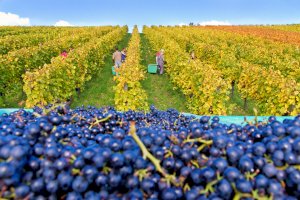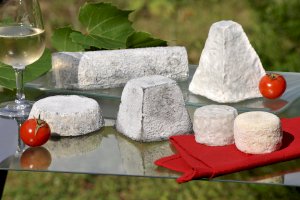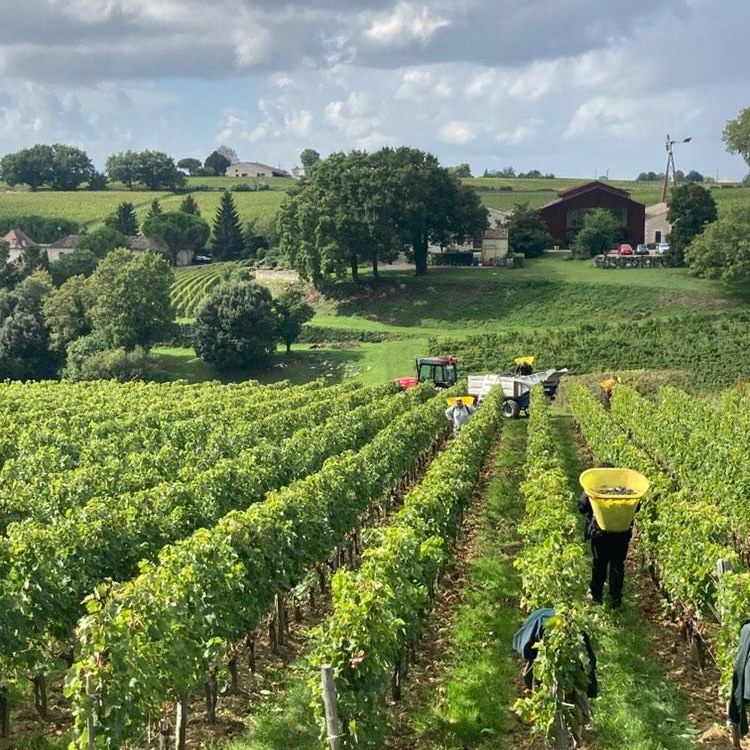-->
 Please wait
Please wait
 Your order is being processed, please wait
Your order is being processed, please wait

All our articles
-
France Key Historical Events
2025 Harvest Season in France : A New Chapter in French Wine
As autumn colors sweep across the French countryside, the 2025 harvest season begins. From Bordeaux to Burgundy, winemakers face new climate challenges while continuing to craft wines...
Read more
-
Best Day Trips in France
Cooler Experiences for Hot Days : Underground Cellars, Rivers & Caves in Southwest France
Beat the summer heat with our most refreshing guided tours, from Bordeaux to Provence.
Read more
-
Best Day Trips in France
Slow Travel in France: 5 Peaceful Escapes to Reconnect This Summer
In a world that moves too fast, travel can offer a much-needed pause. More and more travelers are embracing the art of slow travel, an approach that favors quality over quantity. This...
Read more
-
Contest
Instagram Giveaway – Terms & Conditions (April 2025)
Below are the terms and conditions for our April 2025 Instagram giveaway.
Read more
-
Ophorus events
Celebrating 20 Years of Ophorus: Our Journey Through Milestones
This year, we celebrate a very special milestone: 20 years of passion, service, and unforgettable experiences! From humble beginnings as a passenger transport company in Toulouse,...
Read more
-
Ophorus events
Ophorus Annual Seminar in Strasbourg – January 2025
In January, the Ophorus team gathered for our much-anticipated annual seminar, a 4-day event in Strasbourg. Our Bordeaux office team & the guides from all across France came together...
Read more
-
Popular Destinations in France
Our 5 best-selling tours for 2024
As we step into 2025, it's the perfect time to plan your next adventure in France. Whether you're a wine lover, a history enthusiast, or someone looking to soak in the beauty of picturesque...
Read more
-
Popular Destinations in France
French Christmas celebrations you don't want to miss !
Let's embark on a journey to discover the diverse and enchanting ways in which different French regions celebrate this joyful occasion.
Read more
-
Sought-After Activities in...
Tour de France 2025: Complete Guide to Routes, Winners & History
Discover the complete 2025 Tour de France route, including 21 stages, 5 summit finishes, and legendary climbs. Learn about past champions, jersey competitions, and how to watch cycling's...
Read more
-
Shore Excursions in France
Shore Excursions in France: Exploring Ports from Normandy to the French Riviera
From D-Day beaches to glamorous Monaco, experience the diversity of France's coastal landscapes. Shore excursions offering deep cultural insights, wine tastings, and unforgettable...
Read more
-
Famous Attractions in France
Discover the Most Iconic Cabarets in Paris: A Guide to Unforgettable Nights of Glamour and Spectacle
Discover the most iconic cabarets in Paris, including the Moulin Rouge, Au Lapin Agile, Crazy Horse, and Paradis Latin. Explore their history, dazzling shows, and unique charm with...
Read more
-
France Key Historical Events
Haunted Castles and Chilling Legends: Discover France's Spookiest Spots
When you think of France, images of fine wine, romantic landscapes, and elegant architecture may come to mind. But beneath the charm lies a world filled with eerie legends, haunted...
Read more
-
Popular Destinations in France
Southern France Travel Packages: Provence & French Riviera 2025-2026
Discover the stunning landscapes and rich culture of Southern France with our travel packages. Explore Provence, the French Riviera, Bordeaux, and the Dordogne. Enjoy guided tours,...
Read more
-
Popular Destinations in France
Discover the Magic of France: Exclusive Travel Packages for 2025-2026
Immerse yourself in the beauty of France with our travel packages. Explore iconic destinations like Paris, Normandy, and the Loire Valley. Enjoy guided tours, wine tastings, and luxurious...
Read more
-
Best Day Trips in France
Discover the Best Day Trips in Alsace: Explore Beyond the Vineyards and Villages
Explore the best day trips in Alsace from Strasbourg or Colmar. Discover charming villages, historic castles, and scenic vineyards with tailored small group or private tours.
Read more
-
Best Day Trips in France
Best Day Trips in Nouvelle-Aquitaine: Bordeaux & the Region’s Hidden Gems
Discover the best day trips from in Nouvelle-Aquitaine, France. Explore charming villages, world-class vineyards, and stunning natural landscapes with small group or private tours...
Read more
-
France Key Historical Events
The Olympic Games: A Fun Dive into History and Tourism Through the Ages
The Olympic Games, a grand spectacle of athletic prowess and international camaraderie, have been captivating audiences for over a century.
Read more
-
Best Day Trips in France
OPHORUS Wins Tripadvisor Travelers’ Choice Award 2024Â
OPHORUS Recognized as a Traveler-Favorite Tour Operator !
Read more
-
Shore Excursions in France
Top 10 Shore Excursions from Marseille: Discover the Best Activities for Your Cruise
Discover the top shore excursions from Marseille, including visits to historic landmarks, picturesque villages, and beautiful beaches. Plan your perfect Mediterranean adventure with...
Read more
-
Popular Destinations in France
Honeymooning in Paradise: Unveiling France's Romance, Wine & Hidden Gems
Congratulations! You've tied the knot and now it's time to celebrate your love with an unforgettable honeymoon. Dreaming of sun-drenched beaches, charming villages, and a touch of...
Read more
-
Best Day Trips in France
Unforgettable Day Trips from Paris by Train: Explore France's Gems in a Day!
Tired of just seeing Paris? Explore the magic of France beyond the City of Lights with Ophorus, your one-stop shop for curated day trips accessible by train from Paris!
Read more
-
Best Wine Regions of France
Experience the Best of French Riviera Wine Tours and Tastings
Learn about the vibrant wine culture of the French Riviera, including top tours, key vineyards, and what to pack for an unforgettable wine adventure!
Read more
-
Best Day Trips in France
Provence Lavender Tours: When to Visit & What to Expect
Discover the enchanting lavender fields of Provence with our exclusive guided tours. Experience the charm, history, and beauty of Provence with expert guides, insider access, and hassle-free...
Read more
-
Best Wine Regions of France
Unveiling Burgundy: A Luxurious Wine Tour Adventure (Dijon & Beaune)
Unveil Burgundy's prestigious wines & captivating history on a luxurious wine tour (Dijon & Beaune). Exclusive winery access, curated itineraries & unforgettable experiences await.
Read more
-
Popular Destinations in France
Best Prehistoric Caves in Dordogne for an Immersive Experience
Explore the best prehistoric caves in Dordogne for an immersive experience that history enthusiasts and adventure seekers will love. Discover ancient cave paintings, stunning rock...
Read more
-
Popular Destinations in France
Secret Spots in Provence: Discover the Region's Untouched Beauty
Discover Provence's hidden gems with our guide to secret spots that showcase the region's untouched beauty. From off-the-beaten-path locations to exclusive insider tips, explore unique...
Read more
-
Popular Destinations in France
2024 Guide: 10 Compelling Reasons to Explore Normandy
As we step into the historic year of 2024, there are more reasons than ever to make Normandy your next travel destination.
Read more
-
Best Wine Regions of France
Champagne & Dessert Wine Glasses: Elevate Your Tasting Experience
Elevate your Champagne, dessert wine, and French brandy experience! Explore the science behind specialized glasses and how they enhance aroma, flavor & enjoyment. Book a tasting with...
Read more
-
Popular Destinations in France
Dordogne Castles: Top 5 Must-See Medieval Wonders
Explore Dordogne's enchanting castles! From medieval fortresses to Josephine Baker's estate, discover history, architecture & breathtaking beauty. Book your unforgettable guided Dordogne...
Read more
-
Best Day Trips in France
Unforgettable Loire Valley: Must-See Châteaux, Charming Villages & Wine Tastings
Explore the enchanting Loire Valley: majestic castles (Chambord, Chenonceau!), world-renowned wines (Chinon, Bourgueil!), stunning gardens (Villandry!), & cycling adventures. Day trips...
Read more
-
Best Day Trips in France
Explore Beyond Colmar: 5 Must-Do Day Trips for Every Traveler
Unwind in Colmar & explore Alsace! Captivating day trips await: Strasbourg's grandeur, fairy-tale villages, Alsace Wine Route delights, historic Haut-Koenigsbourg Castle, & Black Forest...
Read more
-
Best Day Trips in France
Discover the Finest Bordeaux Wine Tours of 2024
Unforgettable Bordeaux Wine Tours & Tastings! Explore Saint-Émilion, Médoc, & Graves. Wine blending, chocolate pairing, cheese classes & more! Book your Bordeaux wine adventure today!
Read more
-
Best Wine Regions of France
Luxury Wine Tours in France 2024: Private & Exclusive Experiences
Indulge in luxury wine tours in France 2024. Private tastings, exquisite accommodations, and VIP experiences. Create lasting memories. Limited availability.
Read more
-
Best Day Trips in France
Ultimate 2024 Day Trips from Sarlat: Caves, Castles, Villages & More
With its incredibly preserved villages, unparalleled prehistoric sites and buzzing markets, the Dordogne department of France has a wealth of attractions to fill your visit.
Read more
-
Best Day Trips in France
Bayeux Day Trips 2024: Must-See Sites &Â Beyond the Beaches
Bayeux is the perfect gateway to visit the most important sites the Normandy region has to offer. Striking Chalk cliffs, Historical events, Iconic French Monuments and local delicacies...
Read more
-
Best Day Trips in France
Marseille Day Trips: Explore Provence with Breathtaking Tours
Unwind in charming villages, explore historical wonders, and be captivated by dramatic landscapes on the best day trips from Marseille!
Read more
-
Best Day Trips in France
Beyond Strasbourg: 5 Enchanting Day Trips You Can't Miss
History buffs and wine lovers rejoice! Explore charming towns, medieval castles, and renowned vineyards on these 5 unforgettable day trips from Strasbourg.
Read more
-
Best Day Trips in France
Plan Your Bordeaux Getaway: Top Day Trips for Every Traveler (2024 Guide)
Explore the best of Bordeaux's surroundings! Sample wines in Saint-Émilion, climb the Dune of Pilat in Arcachon, and discover hidden gems on these top day trips from Bordeaux, France.
Read more
-
Popular Destinations in France
Beyond Paris: Exploring France's Top Destinations in June 2024
While Paris undoubtedly holds a special place in the hearts of many travelers, France offers a myriad of captivating destinations beyond its iconic capital. In May 2024, as spring...
Read more
-
Best Day Trips in France
2024 Highlights: Top 5 Day Trips from Aix-en-Provence
Located in the heart of the Provence region in the South of France, Aix en Provence is surrounded by charming hilltop villages, stunning countryside, and historic landmarks. The town...
Read more
-
Popular Destinations in France
Bordeaux Travel Guide: Explore France's Wine Paradise
Unveil the magic of Bordeaux, a captivating city where history, culture, and world-class wine intertwine. This Bordeaux travel guide equips international visitors with everything they...
Read more
-
Popular Destinations in France
Family Trips in France : Discover Our Unforgettable Tours
Planning a family vacation can be both exciting and challenging. Finding activities that cater to all ages and interests is key to ensuring everyone has a memorable experience. Look...
Read more
-
Best Wine Regions of France
Beyond the Vine: Bordeaux's Stunning Winery Architecture
Explore Bordeaux beyond the vineyards! Discover stunning winery architecture with Ophorus Tours. From historic châteaux to modern marvels, embark on a journey through Bordeaux's architectural...
Read more
-
Culinary France
Wine Lover’s Guide: 5 Lesser-Known Alsace Wine Appellations
Discover the hidden gems of Alsace with our guide to the Top 5 Hidden Wine Appellations every enthusiast should know. Unveil these off-the-beaten-path treasures, learn about their...
Read more
-
Culinary France
Why do we eat chocolate at Easter? The origins of the tradition.
Easter, a time of rebirth and renewal, is celebrated in various ways across cultures worldwide. Among the colorful eggs and lively festivities, one tradition stands out: the indulgence...
Read more
-
Popular Destinations in France
The best day trips to plan in France for Easter
As Easter approaches, the allure of springtime in France beckons travelers to explore its picturesque landscapes, historic landmarks, and culinary delights.
Read more
-
Culinary France
5 recipes of various mullet wines just for you !
Star of the Christmas markets, the mulled wine is our little winter pleasure ! Vary the pleasures around this drink thanks to our selection of 5 original recipes.
Read more
-
France Key Historical Events
Enchanted by the Mystical Black Forest : A Halloween Adventure
As the leaves rustle and the air turns crisp, the Black Forest in Germany comes alive with an eerie yet captivating charm, perfectly suited for the Halloween season.
Read more
-
Best Wine Regions of France
The Alsace Wine Route : Celebrating 70 Years of Enchantment
Celebrate the 70th anniversary of the Alsace Wine Route, a legendary itinerary stretching over 170 km from Marlenheim to Thann. Discover magnificent vineyards, castles, and traditional...
Read more
-
Best Wine Regions of France
Experience the Essence of Bordeaux Wine: Flavors, Blends, and Regions Unveiled
Welcome to the world of Bordeaux wine, a captivating journey through France's prestigious winemaking region. Discover the rich history, tantalizing flavors, and exquisite blends that...
Read more
-
Beautiful Villages of France
Discover the Timeless Charm of Beuvron en Auge
Nestled in the heart of the picturesque Normandy countryside, Beuvron en Auge beckons to travelers seeking an authentic European experience. With its cobblestone streets, half-timbered...
Read more
-
Culinary France
A Guide to French Cuisine: From Croissants to Coq au Vin
French cuisine is widely regarded as one of the best and most sophisticated cuisines in the world. The French have a long history of culinary excellence, and their cuisine has influenced...
Read more
-
Stunning Monuments of France
Mont Saint Michel: A Marvel of Medieval Architecture and Spiritual Significance
Mont Saint Michel is one of France's most iconic landmarks, and for good reason. Rising dramatically out of the sea like a fairytale castle, this UNESCO World Heritage site is an architectural...
Read more
-
Best Day Trips in France
Best Day Trips from Paris
Discover the best day trips from Paris and explore the countryside and historic landmarks of France. From the grandeur of Versailles to Giverny, these day trips offer a glimpse into...
Read more
-
Beautiful Villages of France
A Picturesque Gem: Gordes village
When it comes to charming small towns with breathtaking landscapes and rich cultural heritage, Gordes is a name that stands out. Located in the heart of Provence, France, Gordes has...
Read more
-
Charming Small Towns of France
8 Best Things to Do & See in La Rochelle
Located on the Atlantic coast, the town of La Rochelle is directly linked to the ocean. Its dense history, passing from English to French domination, offers an astounding heritage...
Read more
-
Best Wine Regions of France
Red & White Wine Glasses of France
French wine glasses come in a variety of shapes and sizes, each designed to enhance the flavors and aromas of specific types of wine. This article will help you to better understand...
Read more
-
Popular Destinations in France
It's official ! Ophorus now operates tours in the Loire Valley
Our brand-new destination is now available! Starting in April 2023, discover, with our dedicated team, one of the most historical regions of France.
Read more
-
Culinary France
Honey and Cinnamon Christmas Cookies
During the Christmas holidays, have fun making and decorating pretty shortbread cookies that you can give as gifts or enjoy with a cup of tea or coffee ! Warm and delicious, these...
Read more
-
Best Wine Regions of France
Harvest season in France
Do you know the harvest season in France ? This special time for the wine makers is the perfect and unique moment to be part of a wine tour !
Read more
-
Beautiful Villages of France
4 new villages recognized as Most Beautiful Villages of France
4 new Villages ranked as "Most Beautiful Villages of France" in 2022!
Read more
-
Contest
Contest Terms and Conditions
Terms and Conditions of the Contest March 2022
Read more
-
Arts & Crafts of France
11 Luxury Arts & Crafts products of Alsace
Alsace is a region of France that has retained a unique Arts & Crafts tradition. Marquetry, Pottery, Glassware & Crystal are just a few examples of the crafts mastered by local Artisans....
Read more
-
Culinary France
8 Activities to discover Bordeaux off the beaten track
Only a short 2 hour train ride from Paris, Bordeaux is the perfect destination for a unique getaway. Surrounded by world famous vineyards, close by the Atlantic coast and its endless...
Read more
-
Stunning Monuments of France
10 facts you probably didn't know about the Eiffel Tower
The Eiffel Tower - or as we call it in French, La Tour Eiffel - is one of the world’s most famous landmarks. The tower was designed as the masterpiece of the 1889 World's Fair in Paris...
Read more
-
Culinary France
LĂ©a's selection of the best local delicacies from Bordeaux
While in France expect to taste delicious food & wines. When I travel, I always love to spend time in markets and taste food to understand the local culture. Following locals is the...
Read more
-
Best Wine Regions of France
The 5 Most Famous Bordeaux Wine Appellations
The fame of Bordeaux wines is due to their quality, their history, but also to the mind-boggling numbers expressed. Bordeaux vineyard represents the largest productive quality area...
Read more
-
Beautiful Villages of France
Most Beautiful villages of France: Collonges-la-Rouge
Discover one of the most beautiful villages of France located at the border between the historical regions of the Limousin & Quercy. The village is an architectural Gem with all its...
Read more
-
France Key Historical Events
10 facts you probably didn't know about the Normandy D-Day landings
D-Day was the largest invasion by air & sea in military history. Operation "Overlord" involved more than 150 000 troops, 6 900 ships and landing vessels, 2 400 aircraft and 867 gliders....
Read more
Read our most popular
Articles
-
Charming Small Towns of France
8 Best Things to Do & See in La Rochelle
Located on the Atlantic coast, the town of La Rochelle is directly linked to the ocean. Its dense history, passing from English to French domination, offers an astounding heritage...
Read more
-
Best Day Trips in France
Provence Lavender Tours: When to Visit & What to Expect
Discover the enchanting lavender fields of Provence with our exclusive guided tours. Experience the charm, history, and beauty of Provence with expert guides, insider access, and hassle-free...
Read more
-
Stunning Monuments of France
10 facts you probably didn't know about the Eiffel Tower
The Eiffel Tower - or as we call it in French, La Tour Eiffel - is one of the world’s most famous landmarks. The tower was designed as the masterpiece of the 1889 World's Fair in Paris...
Read more
-
Best Wine Regions of France
The 5 Most Famous Bordeaux Wine Appellations
The fame of Bordeaux wines is due to their quality, their history, but also to the mind-boggling numbers expressed. Bordeaux vineyard represents the largest productive quality area...
Read more
-
Sought-After Activities in...
Tour de France 2025: Complete Guide to Routes, Winners & History
Discover the complete 2025 Tour de France route, including 21 stages, 5 summit finishes, and legendary climbs. Learn about past champions, jersey competitions, and how to watch cycling's...
Read more
Explore our latest posts
On Instagram

Secured payments

easy cancellation

trusted reviews

 Please wait
Please wait




























































































